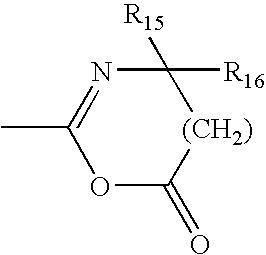Delivery of reactive agents via self emulsification for use in shelf-stable products
a technology of reactive agents and cosmetic actives, applied in the direction of hair removal, hair cosmetics, impression caps, etc., can solve the problems of severely or completely reducing the difficulty of achieving such aqueous compositions
- Summary
- Abstract
- Description
- Claims
- Application Information
AI Technical Summary
Benefits of technology
Problems solved by technology
Method used
Image
Examples
examples
[0142]The following examples further describe and demonstrate embodiments within the scope of the present invention. The examples are given solely for the purpose of illustration and are not to be construed as limitations of the present invention, as many variations thereof are possible without departing from the spirit and scope of the invention. Ingredients are identified by chemical or CTFA name, or otherwise defined below.
[0143]All percentages herein are based upon the total weight of the compositions, and all such weight percentages as they pertain to listed ingredients are based on the active level and, therefore, do not include carriers or by-products that may be included in commercially available materials.
example i
A Non-Limiting Example of a Conditioning Liquid Emulsifiable Concentrate
[0144]
IngredientABCDEPolymer 1114.4015.6816.3413.8413.84Isopar C270.1076.5779.78——Neodol 23-3E310.005.002.505.005.00Heptanol45.502.751.382.752.75Propylene Carbonate5————78.41Cyclomethicone D56———78.41—1Polymer 1 is as described herein, the preparation of which can be referenced in pending U.S. application Ser. No. 09 / 478,855 by R. Glenn et. al, and incorporated by reference.2Available from Exxon3Available from Shell Chemical Company498 wt % in solution, obtained from Aldrich, item #H280-55Available from Huntsman6DOW CORNING 245 FLUID from Dow Corning Corporation, Midland, Mich
[0145]Examples A–E were produced by first dissolving Polymer 1 within the solvent, e.g., isopar C, propylene carbonate or cyclomethicone D5, via stirring for several hours at 50C under closed lid. The neodol 23-3E and heptanol were then added and mixed in for several minutes.
[0146]The above exemplary liquid emulsifiable concentrates of the ...
example ii
A Non-Limiting Example of a Conditioning Liquid Emulsifiable Concentrate
[0149]
IngredientABCDEPolymer II14.4015.6816.3413.8413.84Isopar C170.1076.5779.78——Neodol 23-3E210.005.002.505.005.00Heptanol35.502.751.382.752.75Propylene Carbonate4————78.41Cyclomethicone D55———78.41—1Available from Exxon2Available from Shell Chemical Company398 wt % in solution, obtained from Aldrich, item #H280-54Available from Huntsman5DOW CORNING 245 FLUID from Dow Corning Corporation, Midland, Mich
[0150]Examples A–E were produced by first dissolving Polymer II within the solvent, e.g., isopar C, propylene carbonate or cyclomethicone D5, via stirring for several hours at 50C under closed lid. The neodol 23-3E and heptanol were then added and mixed in for several minutes.
[0151]The above exemplary liquid emulsifiable concentrates of the present invention are to be inter-mixed with a separate aqueous composition(s) immediately prior or simultaneous to application to the hair substrate. A quantity of the liquid...
PUM
| Property | Measurement | Unit |
|---|---|---|
| boiling point | aaaaa | aaaaa |
| particle size | aaaaa | aaaaa |
| particle size | aaaaa | aaaaa |
Abstract
Description
Claims
Application Information
 Login to View More
Login to View More - R&D
- Intellectual Property
- Life Sciences
- Materials
- Tech Scout
- Unparalleled Data Quality
- Higher Quality Content
- 60% Fewer Hallucinations
Browse by: Latest US Patents, China's latest patents, Technical Efficacy Thesaurus, Application Domain, Technology Topic, Popular Technical Reports.
© 2025 PatSnap. All rights reserved.Legal|Privacy policy|Modern Slavery Act Transparency Statement|Sitemap|About US| Contact US: help@patsnap.com



